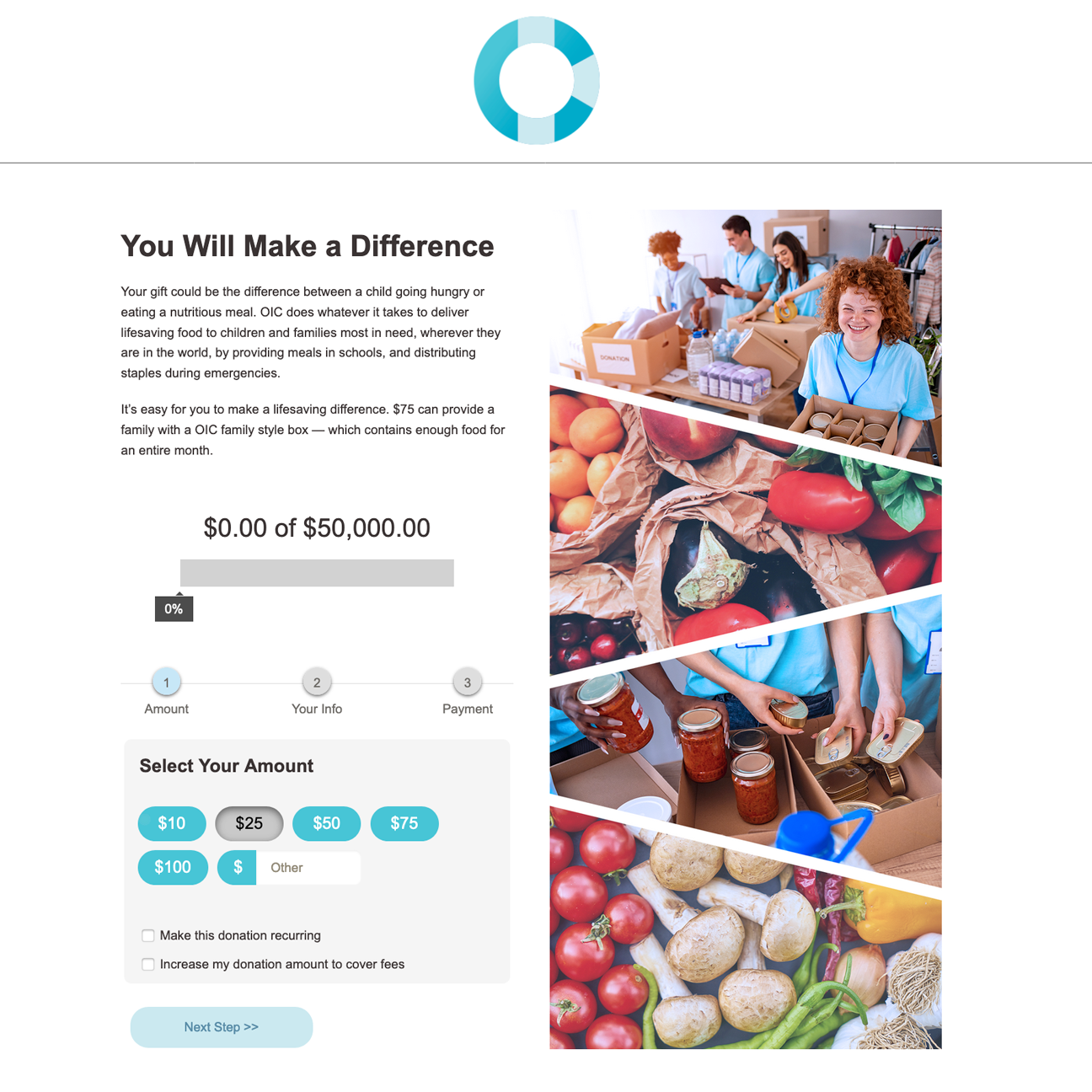Virtual fundraising is any fundraising activity that takes place entirely online, including donations made on your website or through social media channels.
In this article, we’ll discuss a few virtual fundraising best practices, provide recommendations for choosing the best online fundraising software, and share nine online fundraising ideas your nonprofit organization can try right now.
 Peer-to-peer fundraising
Peer-to-peer fundraising software is a great way to leverage your supporters’ networks to raise funds for your organization.
P2P platforms take a little extra work to set up, but they can have significant payoffs. Look for a platform that is easy to use and provides guides to help teams and individuals create their pages quickly.
Your software should also allow for custom dashboard creation to track essential metrics like the number of teams and individual fundraisers, total amount raised, average gift size, and more. You should be able to sync contacts back to your CRM for additional segmentation and outreach.
Peer-to-peer fundraising
Peer-to-peer fundraising software is a great way to leverage your supporters’ networks to raise funds for your organization.
P2P platforms take a little extra work to set up, but they can have significant payoffs. Look for a platform that is easy to use and provides guides to help teams and individuals create their pages quickly.
Your software should also allow for custom dashboard creation to track essential metrics like the number of teams and individual fundraisers, total amount raised, average gift size, and more. You should be able to sync contacts back to your CRM for additional segmentation and outreach.
1. Make virtual fundraising part of your development plan
A development plan is your organization’s financial roadmap for the upcoming year. It charts a course for your fundraising efforts and outlines the strategy you’ll take to make your financial goals a reality. Every development plan should include virtual fundraising. Look at how much money you brought in during your last cycle from online sources. Start simple and examine only donations made through your website. You can use that as your baseline and think about how you might raise that amount again for the upcoming fundraising year. Take a look at how you raised those funds. Did those donations happen because of a specific email? Did they follow a big event where supporters visited your website to give the day after? Did they come in via a peer-to-peer campaign? Categorize your online revenue into specific channels and make those distinctions clear in your development plan’s virtual fundraising section.2. Invest in the right virtual fundraising software
Once you’ve included virtual fundraising in your development plan for the upcoming year, identify the resources you’ll need to implement that plan. This all starts with selecting the right virtual fundraising software. Your software will allow you to automate your marketing and gain a better understanding of your supporters and their online habits. Here are a few online fundraising tools to invest in:Nonprofit CRM
CRM stands for constituent relationship management, and it’s a tool that helps you track your supporters, their contact details, and other important information. Your nonprofit CRM should allow you to create fundraising forms with custom fields and enhance your supporter profiles with rich data. Use your CRM to engage with your supporters via email, social media, and offline efforts too like direct mail. Having all of these features in one place can be a powerful solution for your nonprofit. It will make you more efficient and able to better engage your supporters.Online donation form
Your online donation form is the tool responsible for converting your supporters into new donors and turning one-time donors into recurring contributors. When evaluating virtual fundraising software, look for systems that give you the ability to:- Easily create forms through drag-and-drop form creation.
- Add multiple giving levels and recurring gifts options.
- Accept “in memory” and “honor” gifts.
- Embed fundraising forms on any web platform that will look great on any device.
- Track donor interaction and key metrics, like which supporters donated last year but not this year, event attendees who also contributed, major donors who haven’t given yet, and volunteers who have not donated.
- Immediately acknowledge online gifts with automated but personalized messaging.
 Peer-to-peer fundraising
Peer-to-peer fundraising software is a great way to leverage your supporters’ networks to raise funds for your organization.
P2P platforms take a little extra work to set up, but they can have significant payoffs. Look for a platform that is easy to use and provides guides to help teams and individuals create their pages quickly.
Your software should also allow for custom dashboard creation to track essential metrics like the number of teams and individual fundraisers, total amount raised, average gift size, and more. You should be able to sync contacts back to your CRM for additional segmentation and outreach.
Peer-to-peer fundraising
Peer-to-peer fundraising software is a great way to leverage your supporters’ networks to raise funds for your organization.
P2P platforms take a little extra work to set up, but they can have significant payoffs. Look for a platform that is easy to use and provides guides to help teams and individuals create their pages quickly.
Your software should also allow for custom dashboard creation to track essential metrics like the number of teams and individual fundraisers, total amount raised, average gift size, and more. You should be able to sync contacts back to your CRM for additional segmentation and outreach.
3. Design your virtual fundraising giving form
Your virtual fundraising form’s design will impact how much you raise. When creating online donation forms, make sure to use the following concepts:Frame the ask
Donors like to know their contribution is making a difference, and providing context for why each gift matters can significantly increase your fundraising potential. Give your readers information about how the donation helps the community you serve. A simple statement about where the money goes or what your organization will do with the donation will suffice. For example, you might say that “A $30 donation provides school supplies for one student for an entire year,” or “A $500 gift will keep a family’s heat on this winter.”Give them a choice
Give your potential donors a choice in how their donation is directed. Providing options on your form can be empowering to supporters and help solidify the desire to donate. This can come in the form of donor-directed funds like memorials or just a simple list of different ways someone can donate.Provide motivation
An excellent way to inspire donors is to show them that your organization has the same interests and motivations as they do. Motivate donors by creating specific donation forms dedicated to each issue your nonprofit tackles. If you have multiple issues, consider making multiple forms or give donors the option on a single form to state how they want their gifts allocated.4. Offer a recurring gift option for virtual fundraising
To survive and thrive as a nonprofit, you need a consistent stream of revenue to support operations. One of the best ways to create this consistency is to earn recurring donations. Start by adding a recurring donation option to your virtual fundraising form. Highlight the opportunity to become a recurring donor in your online appeals and provide examples of the impact of recurring gifts on your virtual fundraising page. Once you add recurring donation capabilities through your fundraising software, consider crafting an email marketing campaign targeted at one-time donors. You’ll thank them for their support, remind them how their contribution made a difference, and encourage them to transition to a recurring gift.5. Diversify your virtual fundraising outreach
Your marketing outreach should contain more than just donation appeals. You need a healthy mix of informative content, exciting stories, and good old-fashioned fun. Doing so will improve relations with your current supporters, expand your online presence, and encourage your advocates to get more involved with your organization’s outreach. Using a CRM and marketing automation platform can help you schedule messages ahead of time and automate sending them. Segment your supporters to send targeted messages that are relevant to each group’s interests. In between appeals for donations, throw in a few cute cat GIFs or some other lighthearted graphics that are relevant to your purpose. If your nonprofit has a more professional tone instead, try sharing infographics or peer-reviewed studies.6. Make it easy to find your virtual fundraising form
Make sure your fundraising form is prominently displayed on your website and through your social media streams. On your website, consider adding a button or link to your donation form in these places:- Header or main menu area
- Footer bar
- As a pop-up
- As a full-page welcome mat when new visitors arrive on your website
- In sidebars as a graphical advertisement
- In the footer of individual posts on your blog pages after someone has read the full article
7. Try new virtual fundraising ideas
Each year, hold a brainstorming session to develop new fundraising ideas, or use online resources like our list below:Virtual fundraising idea #1: GivingTuesday
If you haven’t participated in GivingTuesday yet, there’s never been a better time. It’s a global day of fundraising that encourages giving to local nonprofits. Promote your campaign well in advance so supporters can get ready. Then, on fundraising day, encourage donations by creating a sense of urgency that supporters have just 24 hours to give.Virtual fundraising idea #2: Matching gift drives
Matching gifts are an easy way to increase contributions to your organization. Donors who work for companies with matching gift programs can submit a matching gift request to their employer. The employers then donate a gift of equal (or sometimes greater!) value to your organization.Virtual fundraising idea #3: Online education
Do you have expertise in an area that lends itself to an online class? Perhaps an employee or supporter has a particular skill that could make for a fun or entertaining online experience. A Facebook or Instagram live event cooking class may be of interest to the budding chef supporter willing to donate $10 for your take on a great recipe. Or, you might have supporters who want to exercise more but without joining a gym. For them, an online exercise class may be just what they’re looking for.Virtual fundraising idea #4: Social media ads
Sometimes it takes money to make money. Thankfully, online advertising doesn’t have to be expensive. You can get started with just a few dollars, and there is potential for instant results, especially if you already have an active and engaged social network. Some social media sites will even provide nonprofits a discounted rate to advertise on their platforms.Virtual fundraising idea #5: Online auctions
An online auction is an event fundraiser and an online fundraising strategy rolled into one. When procuring items to sell at auction, remember that the less expensive your cost to acquire, the more money your auction will generate. Create a landing page on your website suggesting the types of gifts you think will work best for your audience, and reach out to existing supporters to request donated items. Include a form to let people contact you when they have an item for pickup.Virtual fundraising idea #6: Peer-to-peer event
Peer-to-peer fundraisers can create personalized donation pages and share them with their friends and families to help your organization meet your fundraising goal. This is a great way to turn your in-person activities into online events. Breathe life into your walk-a-thon by adding a peer-to-peer component and expanding your reach. Your fundraising software will handle everything you need to run a successful peer-to-peer fundraising campaign by providing event registration pages, the ability to create a team or individual donation page, and dashboards to analyze fundraising metrics.Virtual fundraising idea #7: Use a petition
Advocacy organizations use petitions to gauge interest in a specific topic among their supporters. Interested and engaged supporters donate at a higher frequency. Next time you launch a petition, instead of merely thanking the petition signer for taking action, redirect them to a post-petition donation form.Virtual fundraising idea #8: Donor recognition campaign
Donor recognition campaigns are a powerful way to draw attention to your organization and encourage a culture of philanthropy among your supporters. Start by creating spotlights for a few existing donors. Ask questions that tease out their reasons for donating to your cause. This can be in written format or put on video as a testimonial. Share them in your email newsletter or on social media with a fundraising appeal and link to your donate page.Virtual fundraising idea #9: Virtual challenges
Virtual challenges can be a fun way to spur supporters to action. They encourage competition, and nearly anyone can participate. Remember the ice bucket challenge? It started online as a fun way to support smaller organizations and was later adopted by the ALS, which reportedly raised more than $100 million worldwide with this one initiative. For your virtual challenge, start by requesting first in exchange for smaller bits of fun. For instance, with the right incentive, your executive director might be persuaded to get soaked in a dunk tank. A member of your local media could join in and bring even more attention to the event. You could also try an event that might not be so wet or chilling! Encourage supporters to take a virtual hike in support of your organization and use GPS or fitness apps to track progress and determine the winner. Or keep things simple by holding a push-up competition, which most people can do in the comfort of their own home.Start planning your next virtual fundraiser
Virtual fundraisers allow you to connect with your supporters even when they’re far away. Reach a larger audience and make giving convenient by investing in the right fundraising software to connect online. Remember to have fun, follow our best practices for virtual fundraising, and try experimenting with new fundraising ideas.
Ready to Get Started?




